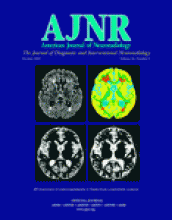We very much appreciated the letter of Dr. Liebeskind as well as the opportunity to reply to his comments. Dr. Liebeskind raises an important point with regard to location, thrombus extent, and early vessel signs (EVSs). His major concern is that not only the presence or location of EVSs, which indicate a thrombus, disclose a distinct vascular pathophysiologic correlate. EVS also represent areas with slow blood flow and therefore may indicate the location and extent of compensatory distal collateral flow (1).
First, the statement that the hyperintense fluid-attenuated inversion recovery sign (FLAIR HVS) and the gradient-echo susceptibility vessel sign (GRE SVS) may represent thrombus, as well as slow and/or retrograde flow (FLAIR HVS) of deoxygenated blood (GRE SVS), is entirely accurate and acknowledged in our manuscript in the second paragraph of the discussion (2, p. 622).
As stated in the introduction, our study had 3 objectives, the first and foremost being diagnostic accuracy of early MR imaging vessel signs. For this, the mere presence as compared with MR angiography (MRA)/perfusion-weighted imaging (PWI) and the concordance of location of the occlusion with the most proximal end of the EVS were analyzed. If present (sensitivity of 65.9%), the proximal end of thrombus/occlusion on FLAIR was correlated significantly (r = 0.66; P < .001) with MRA/PWI. For this diagnostic objective it is not relevant whether the further distal extent of the vessel sign is thrombus or slow flow. We do acknowledge, however, the fact that GRE besides its low sensitivity (34.1%) was not at all correlated with MRA/PWI and is often seen more distally. Whether this represents the distal deoxygenated part of the thrombus or collateral flow of deoxygenated blood is not clear. In fact, this could imply that the sensitivity of the hypointense GRE sign for the clot is substantially <34.1%, because the hyperacute, still- oxygenated clot is not seen within 3 hours. Therefore, if necessary, the FLAIR HVS rather than the GRE SVS should be used diagnostically.
Second, we aimed to assess the prognostic value of early MR imaging vessel signs for clinical outcome, recanalization, and intracranial hemorrhage. Here we did not take collateral status into account. We agree with Dr. Liebeskind that a sufficient collateral status likely is a predictor for a good outcome, if recanalization and reperfusion can be rapidly achieved. We believe, however, that there are also patients with thrombus extending from the proximal middle cerebral artery into distal MCA branches beyond the trifurcation. This has been seen on CT scans where the hyperattenuated MCA sign extends into the MCA branches in the Sylvian fissure (dot sign). We concur that, in acute ischemic stroke, it is imperative to consider the location of proximal flow cessation, the location of thrombus, and the location of compensatory collateral flow. We doubt, however, that early MR imaging vessel signs provide this information reliably and arterial spin-labeling techniques for the assessment of local perfusion are far from being routinely applicable in a timely fashion (5 sections, 20 minutes in healthy patients) (3).
Finally, we hypothesized that the MR imaging signal intensity characteristics of early MR imaging vessel signs may reflect the structure of the intraluminal thrombus in patients with a vessel occlusion and can predict response to recombinant tissue plasminogen activator. Here, the presence or absence of good collaterals could be a stronger predictive parameter—and therefore a confounding variable—we take into account. This issue would have been more important if we had detected that clot composition as supposedly reflected by MR imaging EVS is a positive predictor of therapeutic response. In that case a type 1 error might have occurred.
- Copyright © American Society of Neuroradiology












